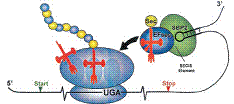Biochemistry, Department of

Vadim Gladyshev Publications
Document Type
Article
Date of this Version
September 2007
Abstract
We used comparative genomics and experimental analyses to show that (1) eukaryotes and archaea, which possess the selenocysteine (Sec) protein insertion machinery contain an enzyme, O-phosphoseryl-transfer RNA (tRNA) [Ser]Sec kinase (designated PSTK), which phosphorylates seryl-tRNA [Ser]Sec to form O-phosphoseryl-tRNA [Ser]Sec and (2) the Sec synthase (SecS) in mammals is a pyridoxal phosphate-containing protein previously described as the soluble liver antigen (SLA). SecS uses the product of PSTK, Ophosphoseryl- tRNA [Ser]Sec, and selenophosphate as substrates to generate selenocysteyltRNA [Ser]Sec. Sec could be synthesized on tRNA [Ser]Sec from selenide, adenosine triphosphate (ATP), and serine using tRNA [Ser]Sec, seryl-tRNA synthetase, PSTK, selenophosphate synthetase, and SecS. The enzyme that synthesizes monoselenophosphate is a previously identified selenoprotein, selenophosphate synthetase 2 (SPS2), whereas the previously identified mammalian selenophosphate synthetase 1 did not serve this function. Monoselenophosphate also served directly in the reaction replacing ATP, selenide, and SPS2, demonstrating that this compound was the active selenium donor. Conservation of the overall pathway of Sec biosynthesis suggests that this pathway is also active in other eukaryotes and archaea that contain selenoproteins.


Comments
Published in Biol Trace Elem Res (2007) 119:234–241.